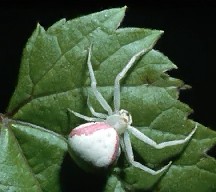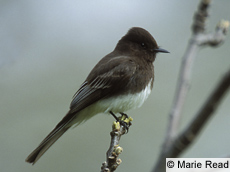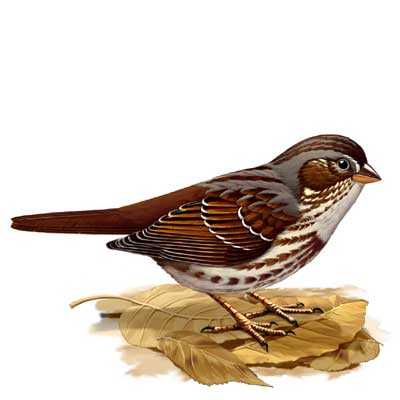Docent Circle: Field Notes Week of 2005-05-15
 Watch for the
appearance of the tiny crab spider this month.
Typical crab spiders are predators that lie in wait to feast
on their prey. You fill find it inside flower heads busily
ambushing flies, bees, and butterflies. This spider builds no web
and changes its color to match whatever flower it is
visiting. Though their chelicerae, or jaws, are rather small
and slender, many crab spiders possess potent venoms that quickly
immobilize their prey. Flower spiders, a particular type of crab
spider, rest on flowers and remain motionless for long periods of
time with their front two pairs of legs extended in readiness.
Watch for the
appearance of the tiny crab spider this month.
Typical crab spiders are predators that lie in wait to feast
on their prey. You fill find it inside flower heads busily
ambushing flies, bees, and butterflies. This spider builds no web
and changes its color to match whatever flower it is
visiting. Though their chelicerae, or jaws, are rather small
and slender, many crab spiders possess potent venoms that quickly
immobilize their prey. Flower spiders, a particular type of crab
spider, rest on flowers and remain motionless for long periods of
time with their front two pairs of legs extended in readiness.
In keeping with their ambush style of attack, many crab spiders
are well camouflaged, blending in with their backgrounds. Some of
the flower spiders are able to change their color over several
days, typically between white and yellow, depending on the color of
the flower on which they are resting. Some resemble tree
bark, leaves, or fruits; others appear to mimic bird droppings.
Their venoms enable them to successfully attack insects much larger
than themselves. They do not wrap their prey in silk after biting,
but instead remain with the immobilized prey until they have sucked
it dry.
Consider encouraging your students to go on a treasure hunt to
find a crab spider - they will relish the facts you can give them
when they find one of these spiders lying in wait, hidden in the
folds of the flower.
 Songbird Foraging is one of the most frequent behavior
birders encounter - and one of the most interesting.
Different birds go about it in different ways. A Black Phoebe
can provide many minutes of entertainment as it sallies from a
perch and snatches up bugs mid-air.
Songbird Foraging is one of the most frequent behavior
birders encounter - and one of the most interesting.
Different birds go about it in different ways. A Black Phoebe
can provide many minutes of entertainment as it sallies from a
perch and snatches up bugs mid-air.
Warblers seem always on the move as they glean insects from
foliage and bark - and take on added interest when one realizes
that different species tend to search in somewhat different
places. Chickadees and bushtits scramble through trees, often
in flocks, frequently hanging upside down to search out an insect
morsel. Swallows zoom along acting as speedy insect nets
ungulfing "aerial plankton" - small flying insects.
 Towhees and fox
sparrows use both feet simultaneously to scratch up litter and
uncover edible items; thrashers sweep and dig with their bills for
the same purpose. Thrushes run along the ground, pause, and
pounce on insects or earthworms. Meadowlarks walk along
bobbing their heads and spearing their prey. You may observe
bluebirds hovering before dropping on prey on the
ground.
Towhees and fox
sparrows use both feet simultaneously to scratch up litter and
uncover edible items; thrashers sweep and dig with their bills for
the same purpose. Thrushes run along the ground, pause, and
pounce on insects or earthworms. Meadowlarks walk along
bobbing their heads and spearing their prey. You may observe
bluebirds hovering before dropping on prey on the
ground.
A given species of bird will often change its foraging behavior
from area to area depending on the kinds of food items that are
available. Watching and recording patterns of foraging can be
a fascinating and useful activity - one that you can encourage your
students to pursue and question.
Awaken Enthusiasm ~ Focus Attention ~ Direct Experience ~ Share
Inspiration
From: Sharing Nature with Children by Joseph Cornell
Back to the Field Notes Archive
 Watch for the
appearance of the tiny crab spider this month.
Typical crab spiders are predators that lie in wait to feast
on their prey. You fill find it inside flower heads busily
ambushing flies, bees, and butterflies. This spider builds no web
and changes its color to match whatever flower it is
visiting. Though their chelicerae, or jaws, are rather small
and slender, many crab spiders possess potent venoms that quickly
immobilize their prey. Flower spiders, a particular type of crab
spider, rest on flowers and remain motionless for long periods of
time with their front two pairs of legs extended in readiness.
Watch for the
appearance of the tiny crab spider this month.
Typical crab spiders are predators that lie in wait to feast
on their prey. You fill find it inside flower heads busily
ambushing flies, bees, and butterflies. This spider builds no web
and changes its color to match whatever flower it is
visiting. Though their chelicerae, or jaws, are rather small
and slender, many crab spiders possess potent venoms that quickly
immobilize their prey. Flower spiders, a particular type of crab
spider, rest on flowers and remain motionless for long periods of
time with their front two pairs of legs extended in readiness.
 Songbird Foraging is one of the most frequent behavior
birders encounter - and one of the most interesting.
Different birds go about it in different ways. A Black Phoebe
can provide many minutes of entertainment as it sallies from a
perch and snatches up bugs mid-air.
Songbird Foraging is one of the most frequent behavior
birders encounter - and one of the most interesting.
Different birds go about it in different ways. A Black Phoebe
can provide many minutes of entertainment as it sallies from a
perch and snatches up bugs mid-air.
 Towhees and fox
sparrows use both feet simultaneously to scratch up litter and
uncover edible items; thrashers sweep and dig with their bills for
the same purpose. Thrushes run along the ground, pause, and
pounce on insects or earthworms. Meadowlarks walk along
bobbing their heads and spearing their prey. You may observe
bluebirds hovering before dropping on prey on the
ground.
Towhees and fox
sparrows use both feet simultaneously to scratch up litter and
uncover edible items; thrashers sweep and dig with their bills for
the same purpose. Thrushes run along the ground, pause, and
pounce on insects or earthworms. Meadowlarks walk along
bobbing their heads and spearing their prey. You may observe
bluebirds hovering before dropping on prey on the
ground.